Biology chapter 13 neurones
1/20
There's no tags or description
Looks like no tags are added yet.
Name | Mastery | Learn | Test | Matching | Spaced |
|---|
No study sessions yet.
21 Terms
motor, relay and sensory
what are the three types of neurones?
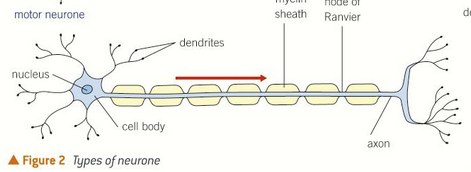
neurones transmit impulses from a relay neuron or sensory neurone to an effector such as a muscle or gland
label parts of motor neurone
what do they do?
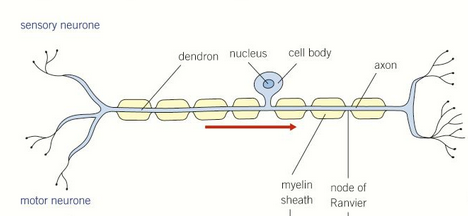
transmit impulses from sensory receptor cell to a relay neurone, motor neurone or brain
what do sensory neurones do
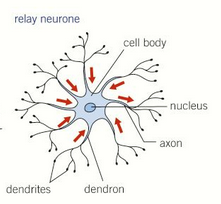
transmit impulses between neurones
what do relay neurones do and look like
nucleus and teh cytoplasm has lots of endoplasmic reticulum and mitochondria to make neurotransmitters
what does the cell body contain?
short extensions from the cell body that split into dendrites. transmit impulses towards cell body
what do dendrons do?
singular elongated nerve fibres that transmit away from cell body
what do axons do?
Schwann cells produce layers of membranes by growing around the axon many times
acts as an insulating layer
allows faster conduction as the action potential jumps between the nodes of Ranvier
called saltatory conduction
what is a myelin sheath and how does it affect trasmission of impulses?
convert stimulus they detect into a nervous impulse.
they are transducers
information passed through nervous system and to CNS.
what do sensory receptors do?
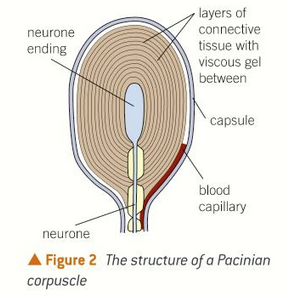
specific sensory receptors that detect mechanical pressure. deep within your skin.
end of the sensory neurone is found within layers of connective tissue.
membrane has Na+ ion channels
what is a pacinian corpuscle?
how do they look (draw)?
structure
in the resting state, the stretch-mediated sodium ion channels in the membrane are closed.
This is the resting potential. Higher Na+ conc outside the cell.
when pressure applied, membrane changes shape
membrane stretches and stretch-mediated Na+ ion channels open
influx of positive ions, the membrane becomes depolarised.
the generator potential creates an action potential
how does pacinian corpuscle converts pressure into a nervous impulse?

-70mV, the outside is more positive than the inside
3 Na+ ions actively transported out
2 K+ ions actively transported into the neurone
done by sodium potassium pump
so more sodium ions outside than inside so sodium ions diffuse back and potassium ions diffuse out
but most of the gated sodium channels are closed while potassium channels are open so more positive outside than inside as K+ diffuses out
what is happening at resting potential in a neurone?
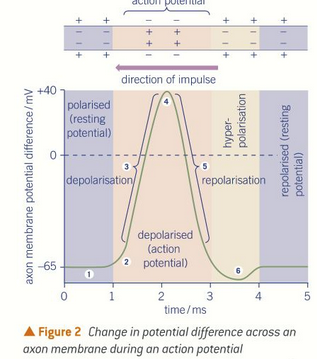
action potential, occurs when protein channels change shape due to a voltage
at the resting potential the potassium ion channels open and sodium VGC are closed.
energy of the stimulus triggers sodium VGC to open and sodium diffuses in. Inside is now more positive.
threshold potential reaches at -50mv which triggers more sodium VGC to open.
when potential difference reaches +40mV the sodium VGC close and the potassium VGC open.
potassium diffuses out, and inside is more negative.
First, lots of potassium diffuse out, but then it becomes hyperpolarised. potassium VGC close.
The sodium-potassium pump causes sodium ions to move out and potassium to move in, returning to the resting potential
what happens to generate an action potential?
When the first region of the membrane is depolarised, this acts as a stimulus for the next region to become depolarised
Once Na+ are inside, they are attracted by the negative charge further along, so they diffuse along.
This causes the sodium VGC further along to open and Na+ moves in.
behind the depolarization, the Na+ VGC close and K+ ones open so K+ ions diffuse out.
returns to a polarised state.
propogation of an action potential
a certain level of stimulus, the threshold value, will always trigger a response
no matter how large the stimulus is, the same size AP is generated
if the threshold is not reached, AP not generated
if stimulus is larger, the frequency of AP increases
what is the all or nothing principle?
axon diameter (the bigger it is, the faster the impulse as less resistance to flow of ions)
temperature (higher temp means faster diffusion)
what two factors other than myelination affect transmision speed?
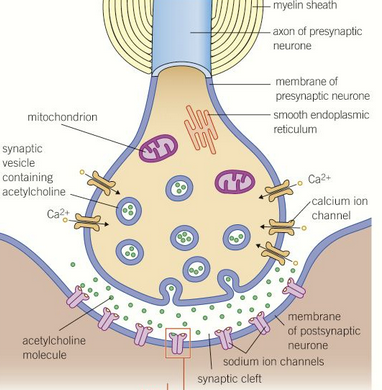
label parts of the synapse
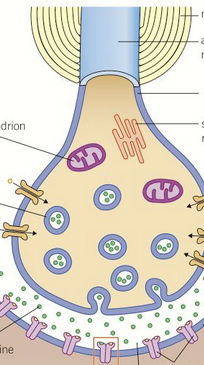
excitatory - result in depolarisation (acetylcholine)
inhibitory - hyperpolarisation of membrane (prevents action potential being generated)
what are the types of neurotransmitters?
action potential reaches pre synaptic knob
depolarisation of membrane and causes calcium ion voltage gated channels to open
Calcium diffuses in
Synaptic vesicles with neurotransmitters fuse and exit by exocytosis and travel across the synaptic cleft
bind to receptor molecules on the postsynaptic membrane
causes sodium ion channels to open
Sodium ions diffuse into the postsynaptic neurone
triggers AP
Then, acetylcholine is broken down by acetylcholinesterase so that the response doesn’t happen again
how are impulses transmitted across the synapse
sometimes the amount of neurotransmitter is not enough to reach threshold potential so the neurotransmitter needs to be built up.
spatial summation - lots of neurones connect to one post synaptic neurone. each one releases enough to trigger AP
temporal summation - single neurone release neurotransmitter several times over a short period to build up. (think: temporal means over time)
what is summation?
what are the two types?
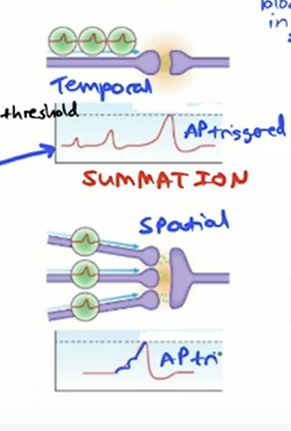
ensure impulses are unidirectional
allow one neurone to transmit to many synapses
or multiple neurones can feed into one neurone
role of synapses